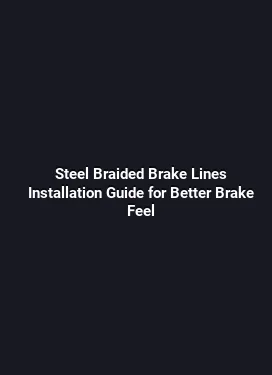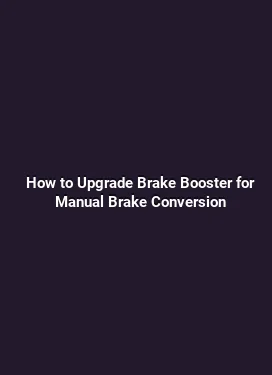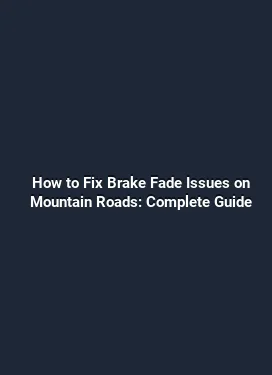How to Convert Drum Brakes to Disc Brakes on Classic Cars
Converting a classic car from drum to disc brakes can significantly improve braking performance, pedal feel, and overall safety while preserving the vehicle’s vintage character. This guide dives into the practical, real-world aspects of planning, selecting components, and completing the swap with careful attention to compatibility, reliability, and daily drivability. Rather than relying on superficial descriptions, the sections below provide actionable details, terminology explained in context, and concrete examples drawn from common classic platforms.
Makale içindeki ilk H2 başlık buraya gelmeli

Disc brake conversions for classic cars involve a balance between maintaining original aesthetics and achieving modern stopping power. The decision typically begins with an assessment of the front axle, where braking force matters most due to weight transfer during stopping. The drum-to-disc upgrade is often most impactful when the vehicle experiences higher speeds or heavier loads, such as highway driving, towing, or spirited back-road sessions. A careful approach considers wheel compatibility, hub geometry, and the availability of factory-looking adapters that preserve the vehicle’s stance and wheel fitment.
Understanding the core differences between drum and disc systems

Drum brakes rely on expanding shoes within a drum to create friction, often offering strong leverage at low speeds but fading with heat and repeated braking. Disc brakes use calipers clamping a rotor, delivering more consistent performance under sustained braking and better heat management. When upgrading, the aim is to replicate or improve brake bias while ensuring the wheels maintain proper clearance and alignment. Disc systems typically provide improved initial bite and better resistance to fade, especially in high-speed or stop-and-go conditions common in vintage car usage today.
Planning Your Conversion: Parts, Tools, and Compatibility
A successful conversion starts with a detailed plan that maps out parts compatibility, installation steps, and potential modifications. The main components include a rotor rotor/hub assembly, calipers, brake hoses or lines, a proportioning valve, a master cylinder, and sometimes a booster. While the exact parts vary by model, there are proven pathways that minimize fabrication while maximizing reliability. The process often leverages parts from modern or later-model vehicles that share similar highway performance profiles and similar hub diameters, making it possible to source a kit or assemble a compatible selection of components.
Assessing hub diameter, bolt pattern, and rotor compatibility
Hub diameter must accommodate the rotor and rotor mounting using the proper bolt circle. If the wheel hub is incompatible with aftermarket rotors, adapter plates can be used, but these should be sourced from reputable manufacturers and installed by someone familiar with brake geometry. In many classic cars, the typical approach involves a two-piece rotor with an integrated hub or a billet hub adapter that preserves the original wheel mounting while providing a modern rotor surface. When evaluating rotor options, consider thickness, venting, and whether the rotor is drilled or slotted for heat dissipation, always matching the caliper mounting points and ensuring adequate clearance for wheel and tire sidewall.
Caliper selection and mounting considerations
Calipers come in various configurations, including single-piston and multi-piston designs. A common strategy is to pair a lightweight, rigid caliper with a high-quality master cylinder and proportioning valve to maintain a balanced brake bias. It is essential to check piston bore size to avoid overly aggressive pedal feel or excessive leverage that could lead to lock-up under certain conditions. Caliper mounting must align with the existing knuckle or spindle geometry, and in some cases, a custom bracket or bracket kit is necessary to achieve proper alignment with the rotor surface and the wheel centerline.
Step-by-Step: Prep, Removal, and Installation
Executing the upgrade in a methodical, well-documented sequence helps ensure a reliable result. The steps below outline a practical path that many hobbyists and professional technicians follow, emphasizing safety, accuracy, and repeatable checks at each stage. Gathering the right tools beforehand—presses, torque wrenches, caliper alignment gauges, and a brake bleed kit—reduces the risk of errors and promotes a smoother workflow.
Preparation and safety considerations
Begin by parking the vehicle on a level surface, applying wheel chocks, and disconnecting the battery to avoid any accidental engagement of electrical systems during work. Elevate the car on jack stands, ensuring a solid, stable setup. Cleanliness is critical; lay out a labeled parts tray for fasteners and use a magnetic tray to keep track of small components. Inspect the surrounding components—bearings, caliper slides, and brake lines—for signs of wear or corrosion to determine whether additional maintenance is needed beyond the conversion.
Removing drums, fabricating or adapting mounting, and fitting rotors
Removing the drum assemblies requires careful detachment of springs, wheel cylinders, and backing plates. Once drums are freed, the next step is to inspect the drum-to-hub interface for any scoring or pitting that could affect rotor seating. If using hub adapters, install them per manufacturer instructions, ensuring the surface is clean and free of debris. The rotor should slide onto the hub or adapter with minimal resistance; if binding occurs, re-check the hub bore, surface finish, and fastening hardware. Caliper mounting must align with the rotor’s flat surface to guarantee even clamping and proper rotor wear patterns over time.
Bringing the caliper, lines, and hydraulic system together
Mount the calipers to the adaptor brackets or factory mounting points, then route the brake hoses or hard lines to the master cylinder. Bleed the system using a two-person method or a pressure bleeder to remove air pockets. When selecting a master cylinder, factor in the wheel cylinder displacement of the drums that were replaced to maintain brake balance. In many retrofits, upgrading to a master with a slightly larger bore helps match the increased hydraulic load of disc brakes, but it must be calibrated to avoid a spongy pedal or excessive travel.
Mastering Bleeding, Proportioning, and Setup
After assembly, the focus shifts to hydraulic concerns, pedal feel, and tuning for predictable, repeatable braking performance. Achieving the right brake bias between the front and rear can prevent under- or over-braking on the rear wheels, which is especially important on classic cars with drum rears. Some installations require an adjustable proportioning valve or a combination valve to fine-tune the balance based on weight distribution and tire performance. Calibrating the system through careful road testing at safe speeds helps ensure the upgrade delivers confident stops under various conditions.
Bleeding sequences, air management, and pedal feel
Bleeding should start from the farthest wheel from the master cylinder, using a consistent method and fresh fluid with proper compatibility ratings. Pay attention to pedal feel, noting whether the brake pedal has a firm, progressive action or a spongy sensation that suggests trapped air or inadequate line routing. If a spongy feel persists, re-bleed and inspect each connection, looking for leaks or degraded seals. As air is expelled, recheck the brake fluid level to avoid cavitation or micro air pockets that can compromise performance under high heat.
Brake bias, ABS compatibility, and daily driviability
Maintaining a safe and predictable pedal response requires a well-balanced system. For classic cars lacking ABS or traction control, a conservative bias is often favored to reduce the risk of front-wheel lock-up. In modern conversions, some owners opt for ABS-compatible modules or electronic brake-force distribution to improve safety without compromising the vintage driving experience. The practical goal is to achieve reliable stopping power with a pedal that feels linear and responsive under everyday driving and occasional spirited use.
Upgrades, Materials, and Fine-Tuning for Daily Driving
Beyond the basic conversion, several upgrades can enhance longevity and performance. For example, choosing rotors with vented cores improves heat dissipation, while high-quality calipers with corrosion-resistant finishes help preserve appearance and function. Stainless steel braided lines can reduce line expansion under heavy braking, providing a more immediate pedal feel. When selecting components, consider lifetime support from the manufacturer, availability of replacement parts, and the ease of future maintenance. Some drivers even experiment with slotted or drilled rotors to manage heat and reduce pad glazing, provided there is good rotor-to-pad compatibility and proper bedding-in procedures.
Wheel fitment, brake torque, and weight transfer considerations
Ensuring the wheels clear the caliper and rotor under steering lock is essential for a reliable setup. If clearance issues arise, selecting a slimmer caliper or adjusting the mounting position through brackets may be necessary. Brake torque must be distributed to prevent excessive front-end loading that could destabilize steering or cause tire scrub. In fixed-axle classic cars, this balance often involves iterative testing and, in some cases, a re-evaluation of spring rates and suspension geometry to accommodate the altered brake response.
Preserving the original character while embracing modern performance
One of the central challenges is achieving a look and feel that aligns with the vehicle’s heritage. Many enthusiasts opt for components that mimic factory lines or utilize period-correct finishes, pairing modern performance with vintage aesthetics. The result is a braking system that honors the classic car’s intent while delivering safer, more reliable stopping power on today’s roads and highways.
Real-World Examples and Practical Tips
Consider a mid-1960s coupe that previously relied on drum brakes at the four corners. By installing a modern disc brake kit on the front, paired with a matched rear disc setup or upgraded drums with improved hydraulics, owners often notice a significant improvement in stopping distance and pedal feel. Practical tips include pre-warming components during installation to ease mounting, verifying wheel offsets early to prevent rubbing, and documenting torque values for future maintenance. Regular inspection of hoses, fittings, and the anti-squeal measures helps maintain a quiet, reliable braking system over years of use.
Maintenance routines and safety checks
After the conversion, establish a routine that includes annual inspections of brake lines, cooling of the brake system during heavy use, and a check of rotor surfaces for signs of uneven wear. Ensuring proper bedding-in of new pads and rotors during the first hundred miles helps maximize pad life and performance. Keep a note of part numbers and supplier details to simplify future replacements, as many classic cars share similar components across model lines, making standardization easier and more economical in the long run.
Seasonal considerations for classic car brakes
In climates with significant temperature fluctuations, brake performance can be impacted by humidity, road salt, and corrosion. Protecting metal surfaces with appropriate coatings and performing periodic disassembly and inspection can prevent rust through the rotor mounting points or caliper slides. For vehicles stored seasonally, consider a light lubrication protocol for pivots and ensure brake fluid is replaced at regular intervals to maintain hydration and viscosity, which supports consistent hydraulic performance.






